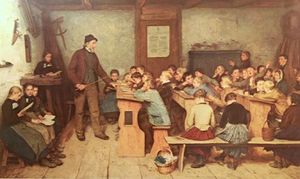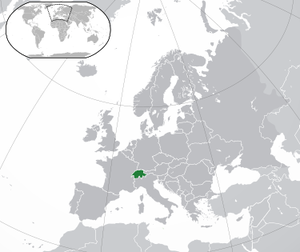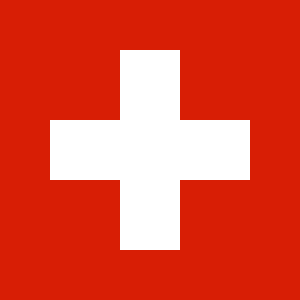Switzerland
| Switzerland {Swiss Confederation) |
|
English and Romansh |
Source information is available at [ Sources ] |
Switzerland, officially the Swiss Confederation, is a landlocked country at the confluence of Western, Central, and Southern Europe. It is a federal republic composed of 26 cantons, with federal authorities based in Bern. Switzerland is bordered by Italy to the south, France to the west, Germany to the north, and Austria and Liechtenstein to the east. It is geographically divided among the Swiss Plateau, the Alps, and the Jura, spanning a total area of 41,285 km2 (15,940 sq mi)[Note 1]and a land area of 39,997 km2 (15,443 sq mi). Although the Alps occupy the greater part of the territory, the Swiss population of approximately 8.5 million is concentrated mainly on the plateau, where the most significant cities and economic centers are Zürich, Geneva, and Basel. These cities are home to several offices of international organizations such as the WTO, the WHO, the ILO, the headquarters of FIFA, the UN's second-largest office, and the main building of the Bank for International Settlements. The leading international airports of Switzerland are also located in these cities.
History
The establishment of the Old Swiss Confederacy in the Late Middle Ages resulted from a series of military successes against Austria and Burgundy. The Peace of Westphalia formally recognized Swiss independence from the Holy Roman Empire in 1648. The Federal Charter of 1291 is considered Switzerland's founding document, celebrated on Swiss National Day. Since the Reformation of the 16th century, Switzerland has maintained a strong policy of armed neutrality; it has not fought an international war since 1815 and did not join the United Nations until 2002. Nevertheless, it pursues an active foreign policy and is frequently involved in peace-building processes worldwide. Switzerland is the birthplace of the Red Cross, one of the world's oldest and best-known humanitarian organizations. It is a founding member of the European Free Trade Association but notably not part of the European Union, the European Economic Area, or the Eurozone. However, it participates in the Schengen Area and the European Single Market through bilateral treaties.
Switzerland occupies the crossroads of Germanic and Romance Europe, as reflected in its four main linguistic and cultural regions: German, French, Italian, and Romansh. Although the majority of the population are German-speaking, Swiss national identity is rooted in a common historical background, shared values such as federalism and direct democracy, as well as Alpine symbolism. Due to its linguistic diversity, Switzerland is known by a variety of native names: Schweiz [ˈʃvaɪts] (German); Suisse [sɥis(ə)] (French); Svizzera [ˈzvittsera] (Italian); and Svizra [ˈʒviːtsrɐ, ˈʒviːtsʁɐ] (Romansh). The Latin name was Confoederatio Helvetica – frequently shortened to "Helvetia" – is used instead of the four national languages on coins and stamps. A developed country, it has the highest nominal wealth per adult and the eighth-highest per capita gross domestic product; it has been considered a tax haven. It ranks highly on international metrics, including economic competitiveness and human development. Its cities, such as Zürich, Geneva, and Basel, rank among the highest in the world in terms of quality of life, albeit with some of the highest living costs. In 2020, IMD placed Switzerland first in attracting skilled workers. The WEF ranks it the fifth most competitive country globally.
Corporal punishment in Switzerland
In the 20th century, school corporal punishment fell out of fashion and was gradually banned in many countries, a trend that continues until the present day.
As of May 2008, Switzerland prohibits corporal punishment in schools.
Parental corporal punishment
Corporal punishment has a long tradition in Switzerland, and the spanking of children for punishment was once common both in the home and in school. The Swiss have a reputation for being hard-working, well-educated but also conservative, and traditional. For example, women were not allowed to vote until 1959 (and in the last canton, until 1990). The age of majority in Switzerland was 20 until it was reduced to 18 in 1996. A 1992 study by Freiburg University showed that about two-thirds of Swiss parents use smacking as a parenting tool. Most corporal punishment was given to small children below the age of four.
According to books and films, common spanking implement in Switzerland seem to have been switches and sticks cut from suitable bushes and trees. Up until the 19th century, the birch rod was also common.
== Switzerland's highest court ==ruled in 2003 that parents have a limited right to smack their children occasionally 'following inappropriate behavior and to educate the child.' The Swiss National Council decided in 2017 against a law that would have made parental spanking illegal.
School corporal punishment
It is unknown whether or when school corporal punishment ended completely in Switzerland. No law legalizes or bans corporal punishment in schools on a national level, but some cantonal school laws ban it.
According to the Atlas der Schweizerischen Schulkunde of 1950, in various regions of Switzerland, the donkey cap was still in use: the student to be punished had to wear it, usually while standing in corner time.
Judicial corporal punishment
Switzerland banned judicial corporal punishment as early as 1798.
Spanking in Switzerland

In the 20th century, school corporal punishment fell out of fashion and was gradually banned in many countries, a trend that continues until the present day.
As of May 2008, Switzerland prohibits corporal punishment in schools.
Corporal punishment has a long tradition in Switzerland, and the spanking of children for punishment was once common both in the home and in school. The Swiss have a reputation for being hard-working, well-educated but also conservative, and traditional. For example, women were not allowed to vote until 1959 (and in the last canton, until 1990). The age of majority in Switzerland was 20 until it was reduced to 18 in 1996. A 1992 study by Freiburg University showed that about two-thirds of Swiss parents use smacking as a parenting tool. Most corporal punishment was given to small children below the age of four.
Common spanking implements in Switzerland, according to books and films, seem to have been switches and sticks which were cut from suitable bushes and trees. Up to the 19th century, the birch rod was common as well. According to the Atlas der Schweizerischen Schulkunde of 1950, in various regions of Switzerland, the donkey cap was still in use: the student to be punished had to wear the donkey cap usually while standing in corner time.
Switzerland banned judicial corporal punishment as early as 1798.
Like several other European countries, Switzerland has recently banned spanking as a parenting method. However, Switzerland's highest court ruled in 2003 [Source 1]that parents have a limited right to smack their children occasionally 'following inappropriate behavior and to educate the child.'
Swiss spanking art
Albert Anker (1831-1910) was a Swiss painter and illustrator who created a number of interesting 19th century school scenes, such as the example above.
A contemporary Swiss spanking artist is t_big who created rendered spanking art (M/B) with Poser.
The BDSM/spanking actress (as well as photo model and video producer) Anastasia Pierce lives in California and Switzerland.
Mainstream and spanking videos
- A Dangerous Method (2011), a mainstream historical film set in Carl Jung's psychiatric clinic in Zurich, includes masochistic spanking scenes.
- Affair at the Swiss School (Nu-West/Leda Productions, 1984), Joanne Jameson, spanking video set in a finishing school (photos, video)
- Reissued in 2012 as Swiss School for Girls
- The Cane and I (Moonglow, 2010), set in a posh Swiss finishing school in the 1960s.
- Chalet Girl (Northern Spanking), Maddy Marks punished at an exclusive Swiss finishing school (photos)
- 1940s Maternal Discipline, Scene One (Momma Spankings, 2023), Clara Hewitt as Felicity West, Samantha Baker, the story includes a Swiss tutor.
Prostitution in Switzerland
- Prostitution in Switzerland ↗ on Wikipedia
Sources
- ↑ http://www.corpun.com/chd00307.htm Switzerland's highest court ruling in 2003
Notes
- ↑ Slightly larger than the state of Maryland (12,405.93 sqmi)
External links
- More information is available at [ Wikipedia:Switzerland ]
Chat rooms • What links here • Copyright info • Contact information • Category:Root

